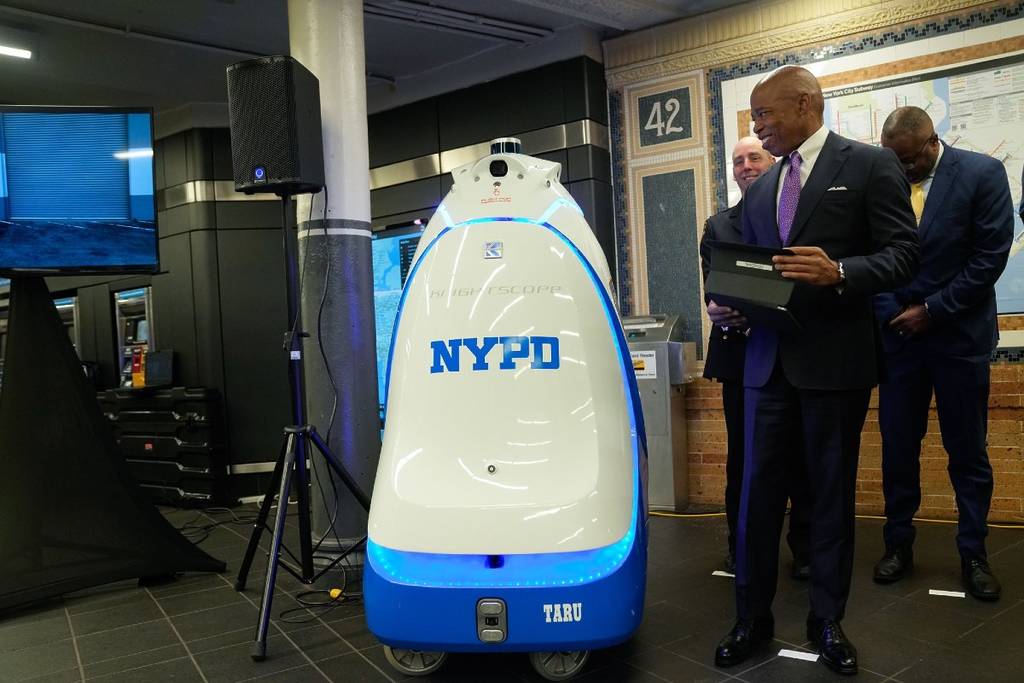NYPD ‘robocop’ no longer patrolling following end of pilot program
The NYPD recently concluded a pilot program for a 400-pound robot dubbed “K5” that was meant to serve as a high-tech surveillance tool and deterrent to subway crime. Despite having an active contract, the robot has been sitting in storage for the past two months.
Deployment in Times Square Station
In early October 2023, the K5 robot was deployed in the Times Square subway station for a two-month pilot program. Equipped with four cameras, it was intended to provide real-time surveillance footage to the NYPD while also acting as a visible deterrent to would-be criminals.
End of Pilot
The two-month pilot ended in early December 2023. Since then, K5 has remained in a storage room in the Times Square station, despite having an active six-month contract with the security contractor Knightscope that supplied it.
No Redeployment
Mayor Adams’ administration has provided no details on why the robot has not been redeployed to another location to fulfill the remainder of its contract. A spokesman simply stated they are “reviewing options” for K5’s next potential deployment.
Cost to Taxpayers
City officials previously announced a seven-month K5 contract would cost approximately $12,250. The current cost spent on the inactive robot is unclear. Mayor Adams had touted the technology as “a good investment in taxpayers’ dollars”, costing only $9 per hour to deploy.
Police Protection Required
During its initial pilot, K5 required accompaniment by two police officers at all times to prevent vandalism. Mayor Adams claimed the officers would no longer be needed after the pilot concluded.
Permanent Deployment Uncertain
It remains uncertain whether K5 will be made a permanent part of the NYPD’s crime prevention strategy once its six-month contract concludes.
Criticisms Over Surveillance
The robot’s debut was met with criticism from legal advocates over subjecting New Yorkers to increased surveillance without clear benefits. Its prolonged inactivity despite an ongoing contract adds doubts about its overall utility.
Questions Over Legality and Usefulness
Watchdogs have questioned whether the rapid deployment of K5 violated city laws requiring public comment on new surveillance tools. With no details on what the robot can do that existing security cameras cannot, some experts view it as an expensive gimmick rather than a worthwhile investment.
Storage Despite Contract
The fact that K5 has sat unused in storage for two months while still under an active contract lends credence to assertions that the robot was always more of a publicity ploy for Mayor Adams rather than a sincere effort to combat subway crime through innovative technology.
Viewed as a Photo Op
Rather than making riders safer, critics argue the temporary spectacle of a high-tech robot served to generate media attention for Mayor Adams with New Yorkers getting “just a toy that the mayor was able to do a photo-op with”.
No Improvement to Safety
According to critics, the K5 pilot did little to actually prevent crimes or improve rider safety. Instead, it subjected citizens to greater levels of surveillance with no discernible benefits in the ongoing effort to secure the subways.
Increased Surveillance Without Benefits
For riders and watchdog groups, the robot’s two-month deployment represents heightened monitoring of public spaces without appropriate safeguards, oversight, or even demonstrated advantages when compared to traditional security cameras.
Conclusion
The NYPD’s trial run of a futuristic subway surveillance robot has ended with uncertainty over whether the technology will be permanently adopted. With no evidence it meaningfully augmented crime prevention efforts compared to existing tools, yet raising alarms over invasive monitoring, the pilot likely did more to garner media attention than substantially improve public safety. Its continued storage despite an active contract also casts doubts on the wisdom of the investment. Moving forward, city officials will need to prioritize approaches that balance innovative policing solutions with transparency and demonstrated effectiveness if the security of New York’s transit system is to be fortified.
FAQs
What was the K5 robot pilot program?
The K5 robot pilot program involved a two-month deployment of a 400-pound surveillance robot in the Times Square subway station, meant to deter crime and provide real-time monitoring.
What is the current status of the K5 robot?
The robot has been in a storage room for the past two months despite having an active 6-month contract with the NYPD.
Why did the pilot end without redeployment?
It is unclear why the NYPD has not redeployed the robot after the pilot concluded in early December. Officials have given no reasons for its continued storage.
What were the main criticisms about the K5 robot?
Critics argued it subjected riders to increased invasive surveillance without demonstrating clear benefits over existing security cameras. Some also questioned its legality.
Did K5 improve public safety?
Watchdog groups found no evidence that the robot prevented crimes or improved rider safety substantially compared to traditional security tools.






